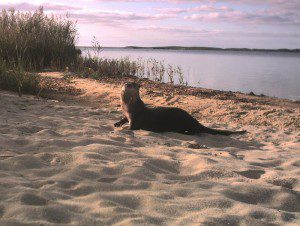Through a grant from Mass. Coastal Zone Management, Waquoit Bay National Estuarine Research Reserve (WBNERR), one of the Mashpee Refuge Partners, hired a consultant to develop a River Restoration Master Plan for the seven tributary streams into Waquoit Bay. Rather than looking at the rivers, and even impediments, on an individual basis, we used a watershed approach to identify and prioritize potential restoration projects so that we would be ready when construction funding becomes available.
Project partners who brought their knowledge and expertise to the table included US Fish and Wildlife Service, MA Fish and Wildlife, Mashpee Wampanoag Tribe, MA Division of Marine Fisheries, Trout Unlimited, and natural resource agents from Falmouth and Mashpee. The result is a comprehensive document that describes impediments to fish passage and other habitat degradation along the streams. Four projects aimed at mitigating these problems were deemed to have overall greater potential, from the standpoints of both construction feasibility and education/research potential. The Plan provides conceptual designs and cost estimates for implementation of three of these projects, and a narrative description of further information needed for the fourth. WBNERR intends to work toward carrying out these projects over the years as funding is available. Projects include:
- a partial breach and nature-like fishway at the Carriage Shop Dam on the Childs River.
- a stream and forested wetland restoration within the footprint of abandoned cranberry bogs on the upper Quashnet River, now owned by the Town of Mashpee.
- a replacement culvert on Abigail Brook.
- a series of former cranberry bog earthen embankments/impoundments with various control structures on the middle reach of the Quashnet. This project would require much more survey and other work for concept drawings to be developed; it is therefore described as a good candidate for restoration, but not brought to the level of planning of the other three.
The projects identified here as part of the Master Planning process include a variety of habitat types to be restored, restoration methods, ownership, and geographic distribution within the watershed.
Waquoit Bay Stream Restoration Master Plan Presentation
Return to Mashpee Refuge Projects.
